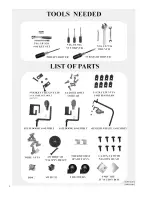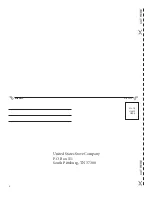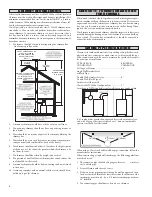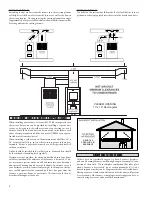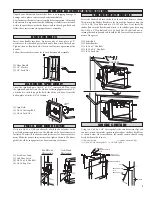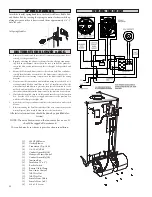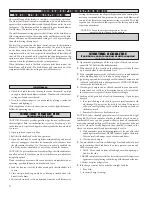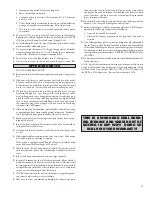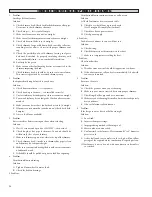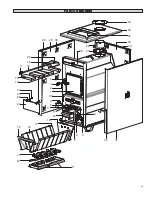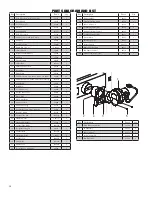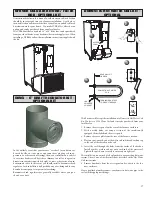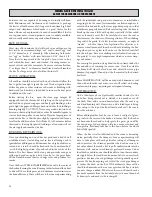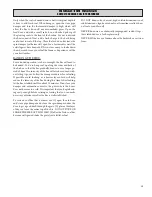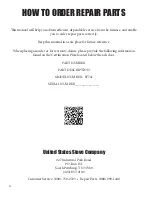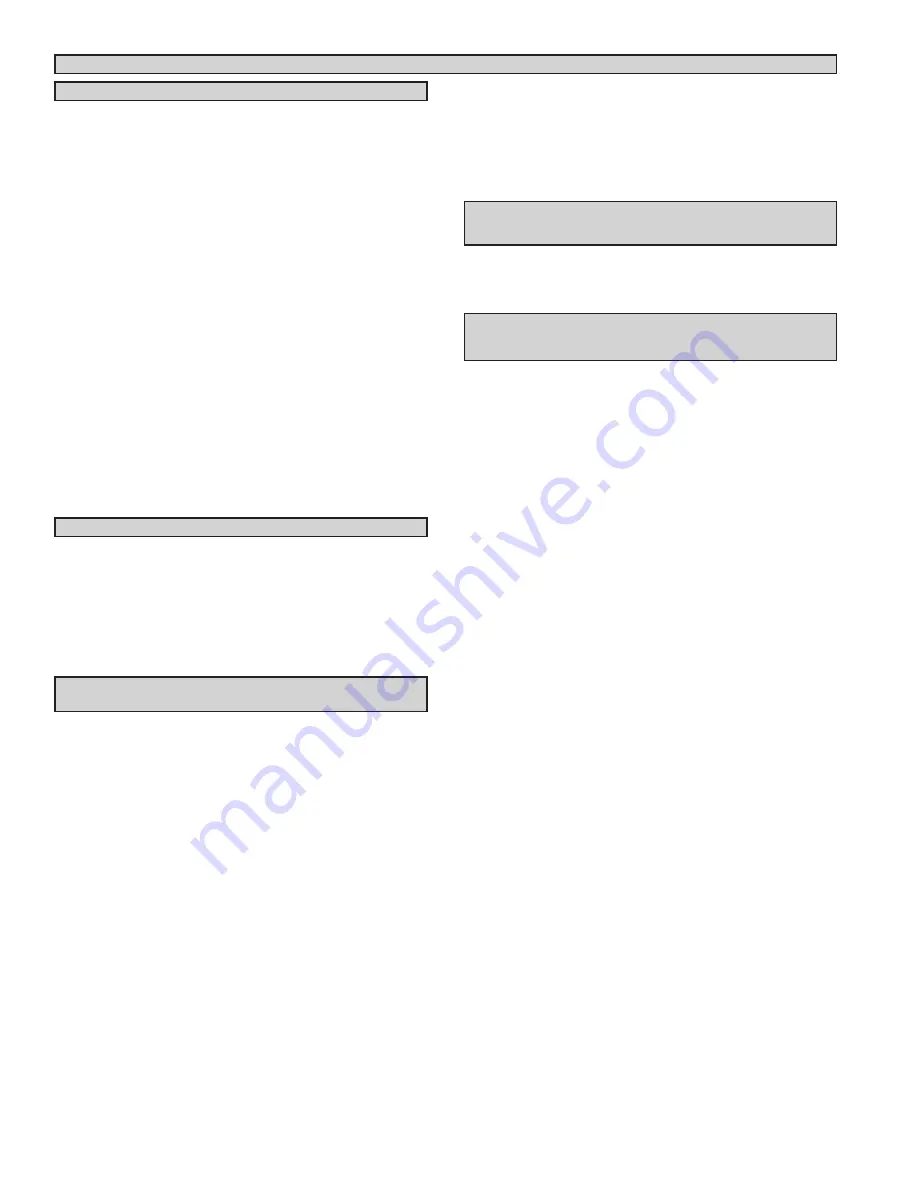
12
After installation of the furnace is complete, it is ready for operation.
The Honeywell Limit Control, in conjunction with a wall thermostat,
operates the distribution blowers and the draft blower on the front of
the furnace. The limit control can be adjusted to your desired blower
On/Off times. The factory settings are 100/150/200.
The wall thermostat setting operates the ON time of the draft blower.
If the temperature is below the setting on the wall thermostat, the draft
blower will come on. (Recommended setting at 5 to 10 degrees higher
than other heating thermostats.)
The first two set points on the limit control operates the distribution
blower(s). When the furnace plenum reaches the second set point
on the limit control, the distribution blower(s) will come on. If the
temperature falls to the first set point, the distribution blower(s) will
shut-off. The rocker switch on the top of the junction box gives you the
option to run one blower or two. If the switch is ON, both blowers will
come on when the plenum reaches the set temperature.
When the furnace reaches the third set point on the limit control, the
draft blower will shut-off. The draft blower will come back on if the
temperature falls below the setting on the wall thermostat.
GENERAL FURNACE OPERATION
TESTING AND OPERATING PROCEDURES
1. Check the draft blower by turning the room thermostat up high
enough so that the draft blower turns on. Then lower the thermostat
setting until you hear it shut off.
2. Use a sheet of newspaper to test your draft by placing it inside the
furnace and lighting it.
With completion of the tests above, you are ready to light the furnace.
Follow the operating steps.
TESTING
STARTING A WOOD FIRE
Using Forced Air Draft
STARTING A COAL FIRE
If you burn coal, a forced air draft is required
Shut off FAD when fuel door is open
Open smoke pipe damper all the way. Open all draft controls on
your AAF747. Pull the slide baffle forward.
Place about 10-15 lb. of coal in on the shaker grates. It should come
up to about half of the first firebrick level.
Place crumpled paper over the coal and crisscross a couple handfuls
of dry kindling wood 3/4” in thickness on top of paper.
Ignite the paper and close loading door. Wait about 30 minutes until
coal fire is established before adding more coal. NOTE: NEVER load
coal over the level of firebrick.
Close by-pass damper and set all draft controls to your own needs.
It may take 3 to 4 coal fires to determine how your local coal and
the furnace reacts together. Adjusts drafts accordingly.
Loading with a good bed of coals in the morning - Open by-pass
damper.
1. In normal shaking, only rock the grates a small amount to sift
ash through. Do not agitate the fire bed too often. This practice
will waste coal. If glowing coal is visible in the ash pan, you have
shaken too much.
2. Remove all ashes every day from ash pit.
CAUTION: Ashes should be placed in a metal container with a tight
fitting lid. The closed container of ashes should be placed on a non-
combustible floor or on the ground well away from all combustible
materials pending final disposal. If the ashes are disposed of by burial
in soil or otherwise locally dispersed, they should be retained in the
closed container until all coals have thoroughly cooled.
3. With your poker, push hot burning embers to the rear of the unit
and add green coal in front. NEVER load over height of firebrick.
This can result in damage to your furnace and home.
4. Close by-pass damper.
Too much draft air will cause clinkering of coal and will waste heat
up the chimney. Shut draft down to as low a point as you can and
still heat your home.
1. NOTE: Never stand in front of loading door when opening it.
Stand to the side.
2. NEVER completely cover the live fire with fresh coal. Always leave
a generous area of glowing coal at the top of the fire and at the rear.
3. Always keep the ash pit clean.
If the fire goes out or does not hold overnight, look for:
1. Poor draft.
2. Incorrect damper settings.
CAUTION: Never use gasoline, gasoline-type lantern fuel, kerosene,
charcoal lighter fluid, or similar liquids to start or “freshen up” a fire
in the furnace. Keep all such liquids well away from the furnace while
it is in use.
1. Open spin draft cap on ash door.
2. Pull the slide baffle rod to the front position.
3. Open the fuel load door and light fire using kindling and several
sheets of newspaper, then close the furnace door. The furnace door
should remain closed for 5 to 10 minutes in order to establish the
fire. If the fire has established, you are ready to load the furnace.
CAUTION: To prevent flame and smoke spillage, the slide baffle must
be pulled out and the fuel door must be cracked for ten seconds before
being fully opened.
Do not over fire your furnace! After you have become familiar with its
operating, you should know how much wood to use.
4. Load the furnace, close the load door and push the slide Baffle rod
to rear.
5. Close the spin draft cap on ash door, leaving it cracked about the
diameter of a dime.
6. The forced air draft cycles on demand from the wall thermostat.
Setting the thermostat four degrees higher than your existing ther
-
mostat is recommended. In operation, the power draft blower will
run until the thermostat temperature setting is reached. The draft
regulator on the forced air draft is preset at the factory and should
require no adjustment.
CAUTION: To avoid excessive temperatures, do not
operate with fuel door or ash pan open.
Summary of Contents for SF747
Page 2: ...2...


